Slate roofing is one of the options for stone covering. The material is expensive and very beautiful. In terms of their characteristics, slate tiles are superior to ceramic ones and are distinguished by exceptional durability.
Features of a slate roof
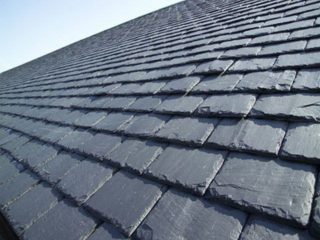
Slate is a clayey rock with a characteristic layered structure. The stone is strong, but if you act on the slab from the end, it can be divided into thin plates, from which the tiles are then made for masonry.
The shale was formed under conditions of elevated temperatures. It does not include pores and capillaries, which guarantees the waterproofing of the roof. Unlike low-porosity metal, shale is less conductive to heat and sound. Such a roof does not ring or rumble during rain, is not afraid of the lowest temperatures or the sun.
The high cost of the material is due to manual production. There is no equipment to mechanically obtain slates from shale. This is done using a manual guillotine, which sharply limits the volume of production.
Another feature is the unusual design. It is impossible to achieve complete uniformity of elements manually. The plates are slightly different and this difference becomes noticeable during laying. However, this only gives the roof a natural look.
Slate is easy to drill. For fastening, holes are made in the tiles.
Specifications
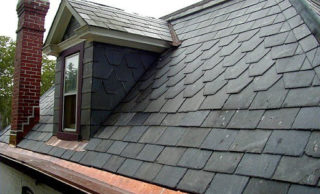
Roofing slate is a slab-like piece of material obtained by dividing the stone into plates and processing the edges. The tiles are polished and given a different geometric shape.
Tile specifications:
- Sizes - from 20 * 25 to 60 * 30 cm. With large dimensions, it is difficult to work with tiles.
- Thickness - from 4 to 9 mm.
- Weight 1 sq. m - 25 kg. When laid twice, the roof weight reaches 50 kg per 1 m². Only reinforced rafters can withstand such a load.
- The minimum tilt angle is 22 degrees. On a steeper slope, smaller custom tiles can be installed.
- Flexural strength - 6 MPa and higher.
The color range of the plates is limited. The natural shade of slate is gray with green splashes, less often brown and dark red. Slate is not dyed.
Types and applications of slate tiles
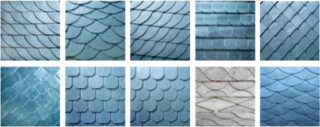
The fine-grained structure of the stone allows you to give it a very different configuration: rectangular scaly, hexagonal, "wild". Today there are 250 tile patterns. It is possible to make tiles according to the shape suggested by the customer.
Rectangular
The classic version. The shape varies from regular square to rectangular elongated. Any sizes. Sometimes the edges of rectangular plates are processed deliberately carelessly in order to emphasize the naturalness of the stone.
This option is most suitable for English styling - in even regular rows or for double masonry. Since uniformity is an advantage here, it is preferable to take tiles of the same color.
Rectangular tiles with rounded edges look interesting.
Scaly shape
The relatively small tile is rounded on three sides. There are such types:
- fish scales - regular triangular shape;
- beaver tail - more like rectangular plates, but with a properly rounded end;
- wild - with clear angles, like octagons.
The scaly shape is chosen when they want to give the roof an unusual look. This option is good in combination with turrets, spitz, and other architectural elements.
Free form
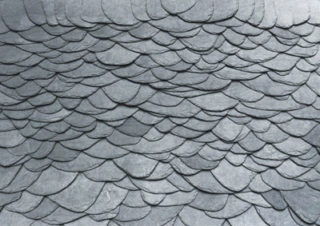
The plates can be shaped as hexagonal, honeycomb, acute-angled, diamond-shaped, rounded. The configuration of the plates influences the way of laying. Rectangular is suitable for English masonry, diamond-shaped is suitable for French.
The more complex the shape of the tile, the more difficult it is to lay it.
Advantages and disadvantages
A slate roof has many advantages:
- The material does not conduct heat well. In winter, it does not allow heat to leave the room, and in summer it does not let the sun's heat inside.
- Oil shale has excellent sound insulation properties. Such a roof does not rumble or ring.
- The plates are heterogeneous but easy to lay.
- Slate is insensitive to corrosion, ultraviolet light and mechanical stress.
- Due to its extremely low porosity, oil shale is resistant to water and frost.
- Laying on slopes, horizontal surfaces, domed and arched surfaces is allowed.
- The stone lasts longer than other materials - up to 200 years.
The thermal expansion coefficient of shale is very low. This allows the plates to be rigidly fastened with screws or nails.
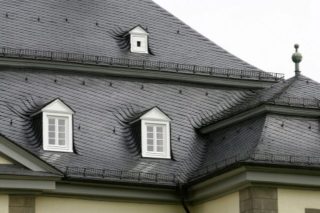
Cons of material:
- Since the tiles are made by hand, their cost is very high - up to 150 euros per 1 m².
- Plates weigh a lot. For such a roof, a reinforced rafter system is needed.
- Extremely poor colors.
A rare and interesting type of slate - with inclusions of mica. These tiles sparkle in the sun and look more spectacular than ordinary tiles.
Preparation for laying slate
Preparation for the installation of slate roofing differs little from the preliminary stage of laying ceramic tiles or artificial material.
- Choose the type of lathing: solid covering or lathing with a step that is less than half the length of the tile. The first option is mechanically more reliable, but the second provides air circulation, which is more important.
- Before the construction of the lathing, all parts are treated with an antiseptic.
- Laying is carried out after all the carpentry work is completed, the lightning rod and antenna are installed, and the drain is secured.
- A vapor barrier material is fixed to the crate.
Before laying, it is worth checking the material. When tapped with a hammer, the roof slate emits a clear metallic sound. If the record sounds dull, it is of poor quality. It is better to cut such an element into 2 parts and use to complete the row.
Tile laying options
There are 3 types of masonry: English, French and German. Plates of different shapes are used for each method.
German
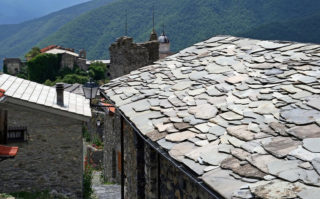
Slate for the "German" roof is taken in a different color. With an approximately rectangular shape, tiles can be of different colors, configurations and sizes. This type of styling is also called "wild". It owes its origin to the poor, forced to cover the roofs with anything.
In fact, the German method turns out to be the most expensive. To build an airtight durable roof from variegated plates, you need to carefully take into account the difference in size and choose such an alternation of tiles that will ensure the tightness of the masonry.
The plates are mounted in ascending rows: the tile located above overlaps the row of underlying tiles. The direction is chosen depending on the direction of the wind: the tiled rows should be placed so that the wind does not penetrate under the plates.
Laying of a scaly roof is carried out by the German method.
French
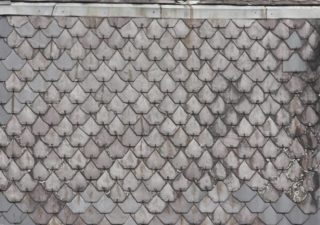
For this method, only diamond-shaped tiles with cut side corners are suitable. The tiles are placed with sharp corners up and down. The material is fixed with nails.
When installed on a ridge, mount 2 rows from the leeward side 40-50 cm above the other slope.
English
Installation is carried out in horizontal rows with vertical overlap and lateral displacement. Each even row turns out to be displaced by half of the plate in relation to the odd one.
Attach the shingles with hooks or copper nails. If the slope is less than 40 degrees, 2 nails are enough to fix each tile. If the angle is more than 40 degrees, you will need 3 nails or hooks.
According to the English method, square, rectangular plates, elements with a pointed or rounded edge are laid.
General rules for installing a slate roof
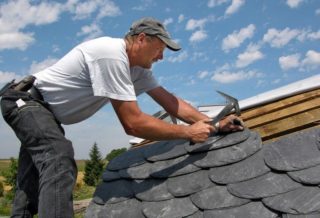
Slate shingles are mounted in compliance with the following requirements:
- Laying is carried out taking into account the prevailing wind direction.
- The tiles are sorted by thickness and size. Thicker plates are placed in areas subject to high stress.
- For fastening, take nails with wide heads. Since the roof serves for a very long time, only stainless steel fasteners are taken.
- The plate is fixed through the holes made during manufacture. Usually 2 nails are used. If the slope of the slope is more than 40 degrees or the area is exposed to a heavy load, the plates are fixed with 3 nails.
- According to the instructions, a gap of 3-5 mm is maintained between the nail head and the tile. This small distance allows the slabs to move when the roof structure deforms. If the plates are fixed too tightly, they will crack.
Slate roofing is not only an original option, but also a practical one. The material does not corrode, has been serving for more than a century, and has excellent heat and sound insulation properties.








